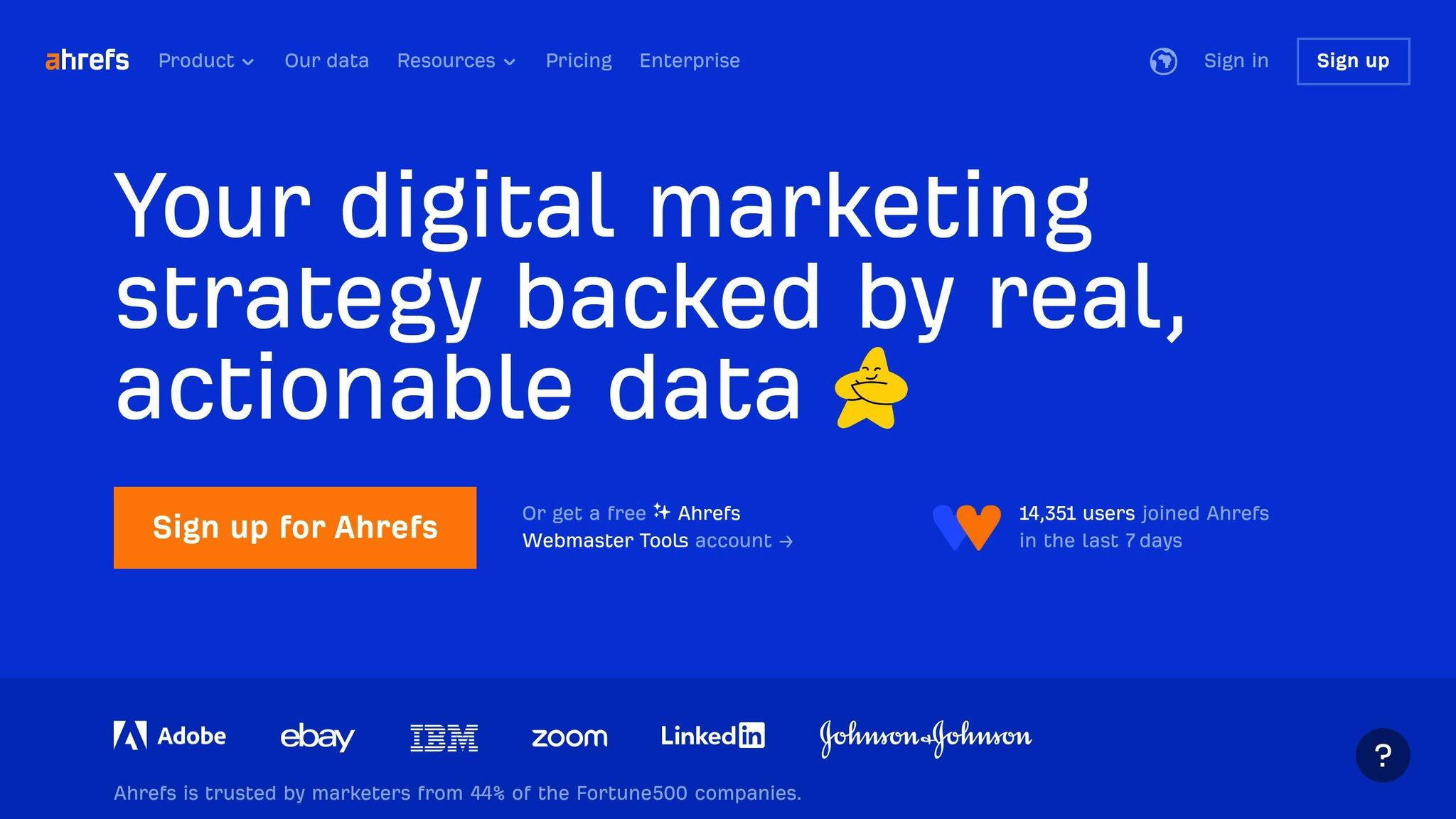B2B content analysis tools help businesses measure and improve the performance of their content across digital platforms. They save time by automating data collection and analysis, providing insights into audience engagement, SEO effectiveness, and content ROI. Here's what you need to know:
- Why They Matter: These tools reveal which content drives traffic, leads, and conversions, helping businesses refine strategies and stay competitive.
- Key Features: Look for tools that track metrics like traffic, engagement, and conversions, offer competitor analysis, and integrate with your existing systems.
- Top Tools: SEMrush (best for all-in-one marketing), Ahrefs (ideal for competitive research), and Google Search Console (great for beginners and free).
Quick Comparison Table
| Tool | Best For | Monthly Pricing | Key Features | Limitations |
|---|---|---|---|---|
| SEMrush | All-in-one content marketing | $139.95 - $499.95 | Comprehensive SEO suite, competitive analysis | Overwhelming for beginners |
| Ahrefs | Competitive intelligence | $129 - $1,394 | Backlink analysis, content gap insights | Limited social media integration |
| Google Search Console | Basic performance tracking | Free | Search performance, Core Web Vitals | No competitive analysis |
These tools help businesses optimize content strategies, improve SEO, and track ROI effectively. Choose the one that aligns with your goals and budget.
Content Analyser Tool from SEMRush, Content Analysis tool

What to Look for in B2B Content Analysis Tools
When it comes to choosing the right content analysis tool for your business, it's crucial to focus on features that truly deliver results. While there are plenty of options available, not all tools are equipped to handle the complexities of B2B marketing cycles or the multi-stakeholder decision-making process.
The most effective tools don't just gather data - they transform it into meaningful insights that align with your business goals. They should integrate smoothly with your existing systems and have the flexibility to grow alongside your content strategy.
Content Performance Metrics and Benchmarking
Metrics like traffic, engagement, and conversion rates are the backbone of any effective content analysis. Together, they provide a complete view of how your content performs at different stages of the buyer's journey. Traffic shows which topics draw in your audience, engagement highlights what keeps them interested, and conversion rates reveal what drives actual business results.
For a competitive edge, benchmarking against industry leaders can help refine your content strategy. By comparing your performance to others in your field, you'll uncover gaps and opportunities, allowing you to focus on the formats and topics that resonate most with your audience.
AI-powered tools are also gaining traction, offering data-driven suggestions to optimize your content for better search engine visibility. These platforms analyze top-performing content in your industry and recommend improvements based on patterns rather than guesswork.
Additionally, tools that track engagement across multiple touchpoints provide deeper insights. They can help identify which content combinations lead to conversions and which might be causing friction in your sales funnel. Ensuring these metrics align with your existing systems will set the stage for seamless integration and long-term scalability.
Integration and Scalability
Integration is key to creating efficient workflows, improving communication, and ensuring consistent data across platforms. Without it, your content analysis tool risks becoming a standalone system, making it harder to turn insights into action.
Research shows that companies with aligned sales and marketing teams see faster revenue growth. In fact, 81% of sales teams are now leveraging AI to improve their processes. Your content analysis tool should bridge the gap between marketing platforms, CRM systems, and sales tools, enabling smooth data sharing.
Opt for tools with open APIs and modular designs that can easily connect to your CRM and marketing platforms. This flexibility ensures your systems can handle growing data volumes and adapt as your tech stack evolves. Relying on tools with limited integrations or proprietary connections could lead to bottlenecks down the line.
| Challenge | Solution |
|---|---|
| Complexity of Existing Workflows and Legacy Systems | Use integration platforms like Apache NiFi, Talend, AWS Glue, or Azure Data Factory; roll out changes in phases; and work with data integration experts. |
| Data Quality and Consistency Issues | Implement tools like OpenRefine or Informatica Data Quality; create cross-functional data governance committees; and schedule regular audits and automated checks. |
| Interoperability and Vendor Lock-In | Choose platforms with open APIs and standards (e.g., REST, OData, SQL); design modular solutions to separate ingestion, storage, and visualization layers; and negotiate data migration-friendly exit clauses. |
To maximize the value of your integrated systems, consider implementing a lead scoring model based on content engagement. This ties content performance directly to sales outcomes, making it easier to justify your investment and fine-tune your strategy.
Compliance and Localization for U.S. Businesses
While integration and performance metrics are critical, compliance is equally important for maintaining trust and avoiding legal risks. In the U.S., businesses must navigate a complex web of data privacy regulations - 20 states have already passed comprehensive privacy laws, and more are likely to follow.
Maintaining compliance with these laws is essential for protecting customer trust and avoiding penalties. A 2019 survey found that 81% of Americans believe the risks of data collection outweigh the benefits. This highlights the importance of transparent and responsible data practices.
Many content analysis tools now include built-in compliance features, such as monitoring data access and generating audit reports. These features can save time and reduce the need for additional software.
"When consumers visit a hospital's website or seek telehealth services, they should not have to worry that their most private and sensitive health information may be disclosed to advertisers and other unnamed, hidden third parties." - Samuel Levine, Director of the FTC's Bureau of Consumer Protection
To ensure compliance, develop a data privacy framework that emphasizes data minimization - collecting only what's necessary for specific purposes. Your content analysis tool should support this approach by offering precise control over data collection and retention.
For U.S.-based businesses, localization also plays a role in usability. Tools should offer customer support during U.S. business hours, use familiar date formats (MM/DD/YYYY), and display currency in dollars to ensure smooth adoption by your team.
Best B2B Content Analysis Tools for 2025
Choosing the right content analysis tool can completely change how your B2B team approaches content strategy. After considering features like performance metrics, competitive insights, and integration options, here are three platforms that consistently stand out for B2B businesses.
SEMrush
For B2B marketers looking for an all-in-one solution, SEMrush offers a robust SEO suite that goes far beyond basic content analysis. Starting at $129.95 per month, it combines organic and paid search strategies seamlessly - perfect for businesses running integrated campaigns. Its Content Marketing Toolkit is a standout feature, offering tools like topic research based on seed keywords and SEO content templates, which many teams find essential.
"Features related to Content Marketing are top-notch. IMO topic research based on a seed keyword and SEO content template are the best features Semrush provides. It has immensely helped us design our content calendar and helped writers with content generation."
– Jainam D., G2 review
SEMrush also shines in competitive analysis, providing visual reports on competitors' traffic sources and revealing their content strategies. It tracks rankings across multiple search engines, including Google, Bing, Baidu, and even ChatGPT, making it a versatile choice. Other highlights include advanced site auditing features like log file analysis, integrated social media tools, and content planning support. With a G2 rating of 4.5 out of 5, SEMrush is a trusted choice for B2B teams, though its extensive features can be overwhelming for smaller operations.
Ahrefs

If competitive intelligence is your priority, Ahrefs is a go-to tool. Known for its simplicity and power, it offers excellent backlink and organic search analysis. Starting at just $20 per month, it delivers enterprise-level capabilities at an accessible price point. Its standout feature is its comprehensive backlink checking tools, paired with unique insights into competitors' organic performance. The "traffic potential" metric for keywords is particularly helpful for uncovering opportunities that might otherwise go unnoticed.
"Ahrefs is a B2B content marketing tool I use the most mainly because of its ability to help me understand my competition. There's nothing more important than knowing who your competitors are and how your content stacks up against theirs."
– Matthew Ramirez, entrepreneur, Forbes 30 Under 30
Ahrefs also offers the Content Explorer feature, which helps marketers identify top-performing content in any niche and pinpoint content gaps. With a G2 rating of 4.6 out of 5, Ahrefs provides the depth needed for organic growth and backlink building without overloading users with unnecessary features.
Google Search Console

For teams just beginning their content analysis journey, Google Search Console is an invaluable, free tool. It provides precise data for managed sites, offering insights into search performance and opportunities for optimization. The Performance and Coverage reports highlight top-performing content and flag indexing issues. Additionally, the Core Web Vitals report ensures that pages meet Google's user experience standards, while the URL Inspection tool helps with testing, indexing requests, and troubleshooting individual pages.
While it doesn’t offer the competitive analysis or keyword research features of paid platforms, Search Console delivers foundational data that many B2B teams depend on as their main source of truth. Its integration with other Google tools, like Google Analytics and Google Ads, makes it a practical choice for businesses just starting out.
These tools pave the way for a detailed comparison in the next section, highlighting their strengths and ideal use cases.
sbb-itb-5be333f
B2B Content Analysis Tools Comparison
When it comes to picking between SEMrush, Ahrefs, and Google Search Console, the right choice largely depends on your goals, budget, and the size of your team. Each tool brings something distinct to the table, so understanding their strengths and limitations will help you make the smartest decision for your B2B content strategy. Below is a quick comparison of their key features, pricing, and best use cases.
Tool Comparison Table
| Tool | Best For | Monthly Pricing | Key Strengths | Main Limitations | Ideal Use Case |
|---|---|---|---|---|---|
| SEMrush | All-in-one content marketing | $139.95 - $499.95 | Comprehensive toolkit for content marketing, competitive analysis, and multi-platform tracking | Can be overwhelming for beginners; higher cost | Perfect for integrated SEO and content planning |
| Ahrefs | Competitive intelligence & backlinks | $129 - $1,394 | In-depth backlink analysis, Content Explorer, and traffic potential metrics | Limited social media integration; focuses mainly on SEO | Great for businesses focusing on organic growth and competitor research |
| Google Search Console | Basic performance tracking | Free | Direct Google data, Core Web Vitals, seamless Google integration | Lacks competitive analysis and robust keyword research | Best for startups and small teams starting with content analysis |
Budget considerations: If you're just starting out, Google Search Console is a solid, cost-free option. On the other hand, premium tools like SEMrush and Ahrefs pack advanced features tailored for more complex needs. It's worth noting that while Ahrefs includes access to all its core tools in its plans, SEMrush may require extra investments for certain features as your requirements grow.
For small B2B teams, Google Search Console might be enough for initial performance tracking - especially when paired with Google Analytics. Mid-sized businesses often benefit from Ahrefs' sharp focus on competitor analysis and backlink strategies. Meanwhile, larger enterprises managing multi-channel campaigns tend to lean on SEMrush for its all-encompassing suite of tools.
SEO consultant and Intellar founder Ben Poulton highlights the strengths of Ahrefs:
"Ahrefs is my go-to software for SEO, and their functionalities for competitor analyses are super helpful right out of the gate. I can create detailed reports on competitive benchmarking by keyword and category. These help me and clients quickly spot gaps, underperforming areas, or highly competitive terms we do well on, but want to make sure we maintain."
Your decision should ultimately reflect your primary content analysis goals. Teams focused on uncovering content gaps and improving backlink profiles may find Ahrefs delivers faster results. In contrast, organizations managing integrated campaigns across various platforms might achieve more with SEMrush's expansive capabilities. For those just beginning, Google Search Console provides a strong foundation to build on before committing to a paid tool.
No single tool is a one-size-fits-all solution. This comparison equips you with the insights needed to select the tool that best suits your objectives.
How to Set Up B2B Content Analysis Tools
Setting up B2B content analysis tools requires a thoughtful approach. Unlike B2C, B2B marketing deals with longer sales cycles, often stretching over months or even years. On top of that, decisions typically involve 6–10 stakeholders, each with their own priorities - whether it’s technical specs or budget constraints. A proper setup ensures smooth data collection and delivers insights that can steer your SEO strategy in the right direction.
Step-by-Step Setup Process
Once you’ve chosen your content analysis tool, here’s how to get it running effectively:
Start by defining success metrics tailored to B2B buyer journeys. Metrics for B2B are different from B2C, where quick conversions are the focus. Here, you need to account for prolonged research phases, multiple decision-makers, and numerous touchpoints. Collaborate with both marketing and sales teams to pinpoint what really matters.
Use a combination of tools like Google Analytics 4 and platforms such as HockeyStack. While Google Analytics 4 can handle baseline metrics, tools like HockeyStack excel at multi-touch attribution, offering insights into the complex buyer journeys typical in B2B. Look for tools that integrate data from CRMs, marketing automation platforms, and other sources into a single dashboard.
Set up strategic goals and account-based tracking. Define goals at different levels - micro-conversions for smaller actions and macro-conversions for larger outcomes. Enable account-based tracking to monitor engagement across various stakeholders. For example, track how different roles interact with your content or how departments engage with specific features.
Integrate with your CRM for seamless data reporting. Connecting your tools to your CRM bridges the gap between marketing efforts and sales results. Many SEO tools offer integration options, making workflows more efficient and data more centralized.
"I plug Frase and Clearscope outputs into Notion boards that I share with our editors and designers. Each content idea gets tagged with details like 'search intent,' 'tone required,' and 'SERP layout expected,' so everyone knows exactly what the piece needs to achieve."
Build custom dashboards with automated reporting. Design dashboards that align with your team’s needs and set up automated reports. These can be sent weekly or monthly, focusing on metrics that directly influence your goals.
Test your setup to ensure everything is tracking properly. Before going live, run tests to verify that your tools are capturing the full B2B journey. Make sure your team is comfortable using the tools and understands how to interpret the data.
Once your tools are up and running, the next step is to keep things optimized with ongoing best practices.
Best Practices for Ongoing Use
Regularly review your performance. David Haskins from WrongfulDeathLawyer.com suggests a smart approach:
"In our monthly editorial retrospectives, I always include a 'keyword decay audit' using SISTRIX's visibility index across a 90-day window. It helps me spot which articles have slowly lost traction, even if traffic hasn't crashed outright."
Prioritize optimizing high-impact content. Instead of trying to improve everything, focus on content that resonates most with your audience and drives key actions. Use AI tools to simplify data collection, predict trends, and generate actionable insights.
Encourage collaboration across teams. Keep marketing and sales teams aligned through regular meetings. Shared dashboards can help track progress and ensure everyone is on the same page when it comes to content strategy and business objectives.
Conduct annual content audits. At least once a year, review your content to identify what’s underperforming and what can be improved. Update existing pieces based on new insights, rather than leaving them untouched.
Adopt advanced automation techniques. Lacey Jarvis from AAA State of Play highlights how automation can simplify processes:
"I have a custom script that runs a SurferSEO content score against the top 5 competing URLs before I even start writing a single word…It's less about stuffing in keywords and more about matching the intent and structure users already respond to."
Document your processes for consistency. A detailed marketing plan covering goals, audience, brand voice, content formats, and distribution channels is invaluable as your team grows. It ensures everyone is aligned and helps streamline your workflows.
Focus on tracking meaningful metrics. According to research, 94% of top-performing content marketers rely on KPIs to gauge effectiveness. Make sure you’re analyzing metrics that tie directly to your business outcomes. Evaluate content performance across all relevant channels, not just individual platforms.
Treat your content analysis tools as part of a larger system, not standalone solutions. By continually refining your processes, aligning your team, and measuring what matters, you’ll ensure your tools deliver maximum value over time.
Conclusion
B2B content analysis tools play a critical role in boosting SEO performance and driving measurable business growth. With organic search accounting for 53.3% of all website traffic and 70% of marketers considering SEO more effective than PPC, having the right tools in your arsenal is a must.
The B2B buyer journey is often complex, requiring in-depth analytics that go far beyond surface-level metrics. Tools like SEMrush, with its robust keyword reporting, and Ahrefs, offering multi-search engine insights, provide the kind of data-driven solutions needed to navigate these intricate pathways. Each tool brings its own strengths, tailored to meet a variety of B2B needs, making it essential to rely on trusted resources when choosing the right fit.
That said, the sheer number of options can feel overwhelming. This is where curated resources become invaluable. As Ross Simmonds, Founder of Hustle & Grind, puts it:
"Quality content curators help us find the content that matters. The best content curators understand their audience and strive to only share high-value content that is aligned with their interests."
A resource like Top SEO Marketing Directory simplifies the selection process by offering a vetted list of tools. Instead of spending weeks researching and comparing platforms, businesses can quickly access pre-screened options - from technical SEO tools to content optimization platforms - designed to match their needs and budgets.
Whether you're a small business leveraging free tools like Google Search Console or a larger enterprise requiring advanced analytics, the first step is conducting a thorough SEO audit. This audit helps pinpoint areas for improvement and lays the foundation for a focused content strategy aligned with your target audience and keywords.
FAQs
What should businesses consider when deciding between SEMrush, Ahrefs, and Google Search Console for content analysis?
When choosing between SEMrush, Ahrefs, and Google Search Console, it’s all about aligning the tool with your business objectives.
- SEMrush is a go-to for businesses aiming to tackle comprehensive marketing strategies. It provides a variety of tools for SEO, advertising, and social media, backed by an extensive database for detailed insights.
- Ahrefs shines when it comes to backlink analysis and keyword research. If your focus is on link-building and gaining deeper SEO insights, this tool is a strong contender.
- Google Search Console is a free option tailored for monitoring website performance. It’s perfect for fixing technical issues and understanding search traffic, making it a great choice for businesses prioritizing site health and technical SEO.
Your decision ultimately hinges on whether you need a broad marketing toolkit, specialized SEO analysis, or a solution for technical optimization.
How can B2B content analysis tools work with CRM and marketing platforms to improve decision-making?
Integrating B2B content analysis tools with your CRM and marketing platforms can take your data-driven decision-making to the next level. By linking these systems, you create a seamless flow of information that improves lead tracking, uncovers richer customer insights, and makes campaign adjustments far more effective.
To make this process work smoothly, start by setting clear objectives and ensuring data accuracy and security remain top priorities. Leveraging APIs and aligning data structures between platforms can help ensure everything syncs properly. Once integrated, you'll have a unified view of performance metrics, giving your team the ability to make smarter, more strategic choices that fuel business growth.
How can businesses in the U.S. ensure compliance with data privacy regulations when using content analysis tools?
To align with U.S. data privacy regulations, businesses need to adopt several essential practices. First, conducting data privacy impact assessments is a smart way to spot potential risks and ensure that robust safeguards are in place to protect sensitive information. This proactive step helps identify vulnerabilities before they become issues.
Another critical measure is implementing strict data access controls. By limiting who can access sensitive data, businesses can significantly reduce the chances of unauthorized access or misuse.
For added efficiency, businesses might consider leveraging privacy management software. These tools can automate compliance tasks, track data flows, and minimize the likelihood of breaches. They also help organizations stay compliant with laws like the California Consumer Privacy Act (CCPA), while showcasing accountability and lowering the risk of legal complications.


